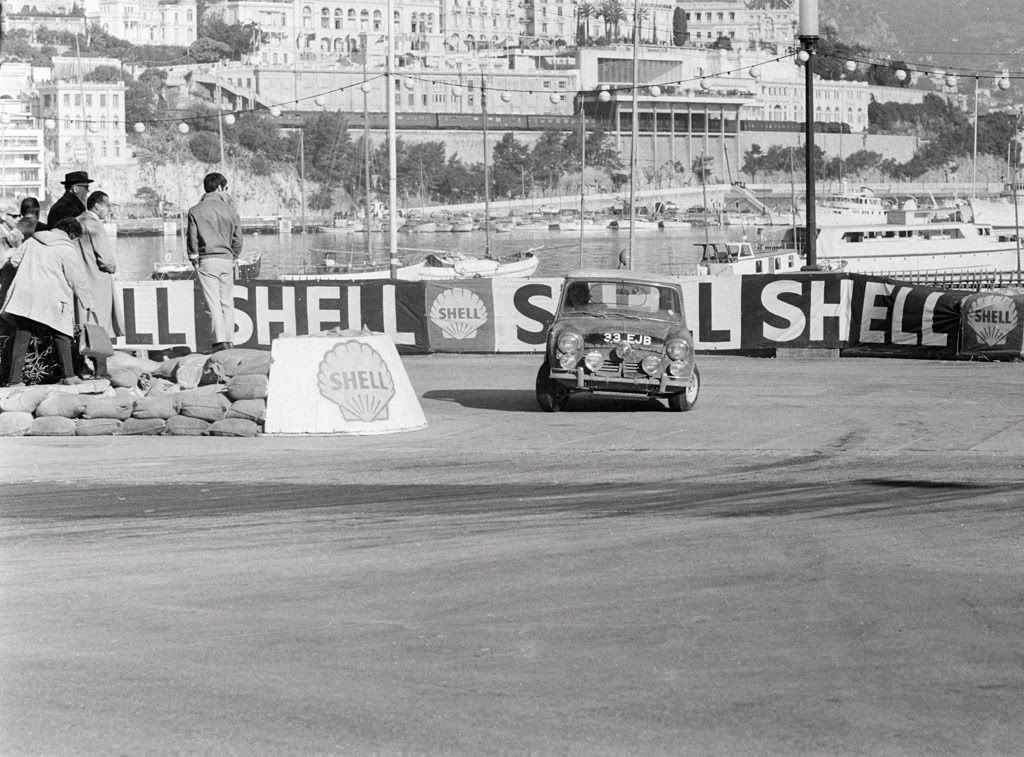




1964 Rallye Monte Carlo

The Monte Carlo Rally promised to be more exciting than ever in 1964. And what had become increasingly evident in the years before then became a clear fact on 17 January 1964. The era of the amateurs was coming to an end, with more and more works teams now entering the Monte. The ultra-powerful Ford Falcons of Greder/Delalande and Schlesser/Leguezec were matched by the Mercedes-Benz 300 SE driven by Bohringer/Kaiser and Glemser/Braungart. But Trana/Lindstrom at the wheel of a Volvo 544 also expected to look good, just like Toivonen/Jarvi in their Volkswagen 1500. Citroen entered no less than four DS 19s, but in terms of sheer numbers everyone still lagged behind the BMC, registering an six nimble Minis, with 24 more Minis being raced by private teams.
Mini drivers Patrick Hopkirk and Henry Liddon set out on the Monte with another Mini team: Rauno Aaltonen and Tony Ambrose. In 1963 Aaltonen and Hopkirk finished first and second in their class, the Flying Finn even clinching third place overall. And in 1964 they entered the race with a new and even more powerful car: the new Cooper S with a larger engine which displaced 1071 cc, developing maximum output of 70 bhp (52 kW). Not only the higher top speed of 99 mph (160 km/h) promised to make the Mini more competitive, but also, much faster acceleration to 60 mph (100 km/h) in 13 instead of 19 seconds.
The Rally started out very well for the Mini drivers in their compact racing machines: The average speed of all cars on their 2485 mile (4 000 km) trip to Reims is 31 mph (50 kph). Only 277 cars reached this first destination, all the works Minis among them. In this famous French city, the race officials carefully make a note of the number plates on the three red Minis with their white roofs destined to become legend: 33 EJB driven by Paddy Hopkirk, LBL 6D with Rauno Aaltonen at the wheel, and AJB 44B piloted by Timo Makinen.
The first leg of the Rally finished all teams in Saint Claude, with a distance of 370 miles (597 km) . After the 14 mile (23 km) special trial between Saint Didier and Mont Main, the Ford Falcons with their 4.7-litre 8-cylinder power units appeared to confirm their leading role, Bo Ljungfeldt ranking first with Patrick Hopkirk only being 16 seconds behind in his Mini Cooper S.
The nimble Minis did not have a very good chance of keeping these leading positions, since they were not built for very high speeds. And the next leg of the race, from La Madelaine to Pelle Autiers, is a 29 mile (46 km) full throttle trial.The nature of this course was reflected by the ranking at the end of the day: Ljungfeldt remained in the lead with his Ford Falcon, Trana was now in second place in his humpback Volvo. But the Minis put up a tremendous show all the same, Paddy Hopkirk dropping back only one place to third.
Entering the next decisive and most demanding day, the teams use all their resources and special ploys to achieve the best possible result: Scouts drive the same icy route as late as possible prior to the start of the race in order to warn the drivers of critical spots. Prior to the night, Ljungfeldt's Ford is 65 seconds ahead of the Minis. But, Ljungfeldt's large engine was a disadvantage, since the rule in the Monte Carlo Rally stated that drivers with larger engines have to drive faster to avoid penalty points. Ljungfeldt hurled his car through the serpentines up to Col de Turini at an altitude of 5 271 feet (1 607 metres), but the weight of his Ford Falcon, the sheer size of the car and rear-wheel drive prove to be a disadvantage on deep snow. Thge Mini Coopers, in turn, compensated their lack of power through their nimble handling combined with front-wheel drive.
Reaching the finish line at the end of the second leg, Ljungfeldt was only 17 seconds ahead of Hopkirk. And according to the handicap formula, the Irish driver was now in the lead in his Mini Cooper with 2,152.1 penalty points. Second was Saab driver Eric Carlsson with 2,183.2 points. Makinen has also moved up one place, 2,216 points putting him just 0.2 points ahead of Ljungfeldt.
The only chance the Ford Falcon driver had for victory is to win the final circuit race on the Grand Prix city track in Monaco, included for the last time in the Monte Carlo Rally. Ljungfeldt pushed the Falcon round the circuit as fast as he can, with only Schlesser being able to keep up. But Paddy Hopkirk didn't give the Mini Cooper a rest, finishing only half a minute behind Ljungfeldt and thus clinching victory in the 1964 Monte Carlo Rally. So at the end of the race Paddy Hopkirk was the winner with 2,536.2 points, Bo Ljungfeldt finished second with 2,566.7 points, and Carlsson was third with 2,573.7 points. To round off the Mini Coopers' triumphant appearance, Makinen finished fourth with 2,593.8 points. The works strategy had proven successful in every respect.